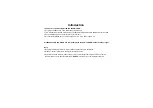
A Quick Look at the Features
Here are brief descriptions of some features, including what each one does and how
you might want to use it. You will have the Conference, Drop, Hold, Message, Mute,
Select, Select Ring, Self-Test, and Transfer voice features and Message Retrieval and
Normal mode among the display features. You may also be able to use the
Speakerphone (and Reset Speakerphone) or the Speaker feature. In addition, you may
have many of the other features listed here; your System Manager can advise you.
Abbreviated Dialing (AD) Allows you to store selected telephone numbers as 3 or
fewer digits for quick and easy dialing. Each number can be a complete or partial
telephone number, an extension number, or a trunk or feature code. There are 3
possible types of lists — personal, group, and system — and you can have a total of 3
lists. Numbers on a personal list are programmable by you; numbers on group lists
are programmable by the controller of the list; system lists are programmable only by
the System Manager. Use this feature as a timesaver for dialing frequently called,
lengthy, or emergency numbers. Note: Check with your System Manager for the
types of lists you have and how many of each.
Automatic Callback Sends you a special 3-burst ring tone indicating that a
previously busy extension is now available. Use to avoid constant redialing when you
want to speak to someone who is frequently busy on the telephone. Note: You can
use this feature only for extensions, not outside numbers.
Bridging Permits you to answer or join calls to someone else’s extension by pressing
a bridged appearance button on your telephone. This button can be any call
appearance labeled with another user's primary extension number, as assigned to you
by your System Manager. Use to assist in handling calls for a designated co-worker.
Call Coverage Provides automatic redirection of certain calls to your telephone for
answering. (Your System Manager determines which calls will be sent to you.) Use to
answer calls for other extensions for whom you provide coverage. Call Coverage can
also automatically redirect your calls when your telephone is busy, you are out of the
office, or you have pressed Send All Calls button.
Call Forwarding — Busy/Don't Answer Temporarily forwards all your calls to
another extension or to the attendant if your telephone is busy or you do not answer
your calls within a preset number of rings. Use when you want your calls to be
forwarded to a telephone number of your choice.
Call Forwarding — Follow Me Temporarily forwards all your calls to another
extension or to an outside number, depending on your system. Use when you want
your calls to be automatically forwarded to a telephone number of your choice.
Call Park Puts a call on hold at your telephone, for retrieval at any extension. Use
when you need to go elsewhere to get information during a call, or whenever you
want to complete a call from a different location. Also, if the call received is for
someone else, use it to hold the call until the called party can answer from the nearest
available telephone.
Call Pickup Lets you answer a call at your telephone for another extension in your
pickup group. Use when you want to handle a call for a group member who is absent
or otherwise unable to answer. Note: You can use this feature only if you and the
called party have been assigned to the same pickup group by your System Manager.
4









































